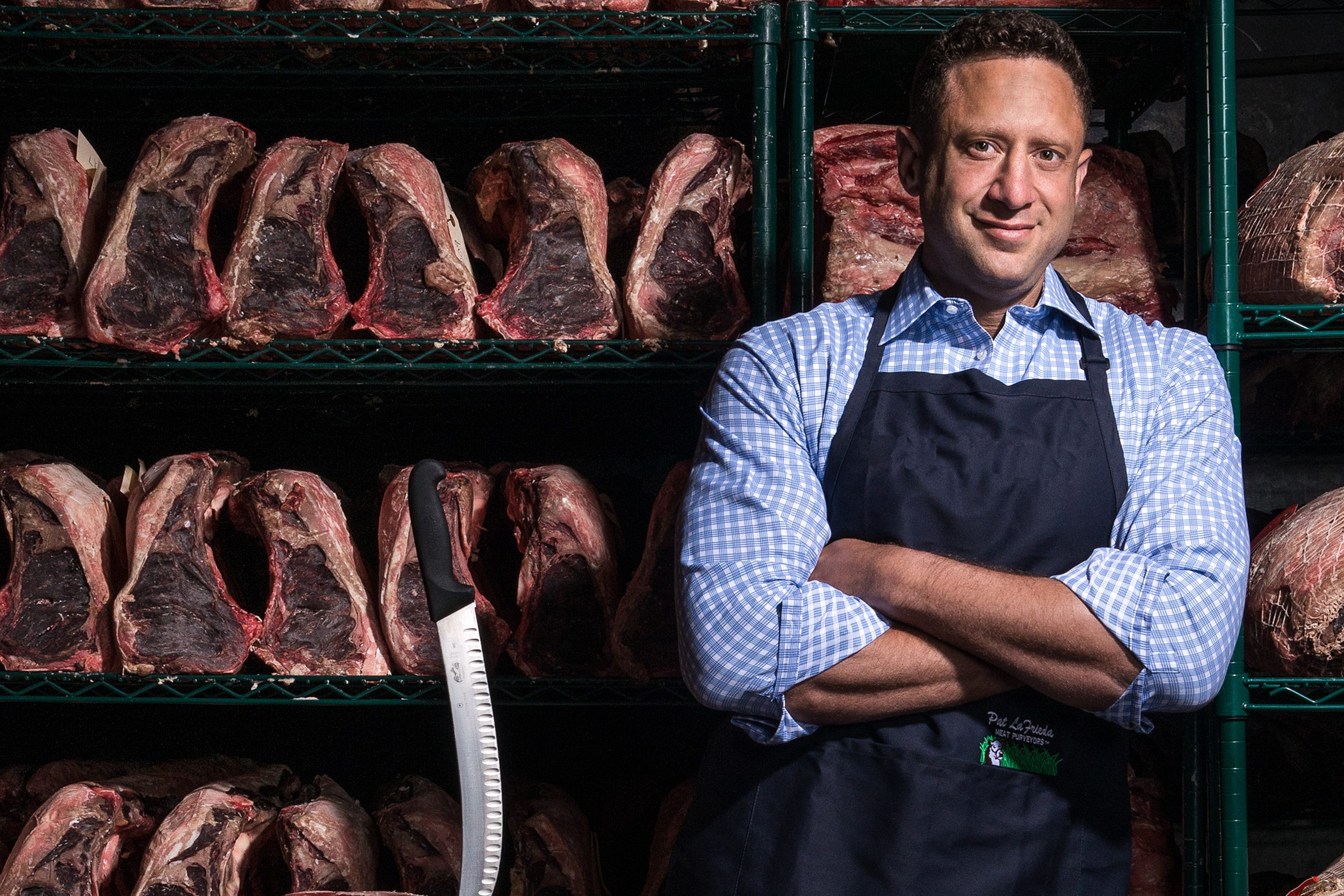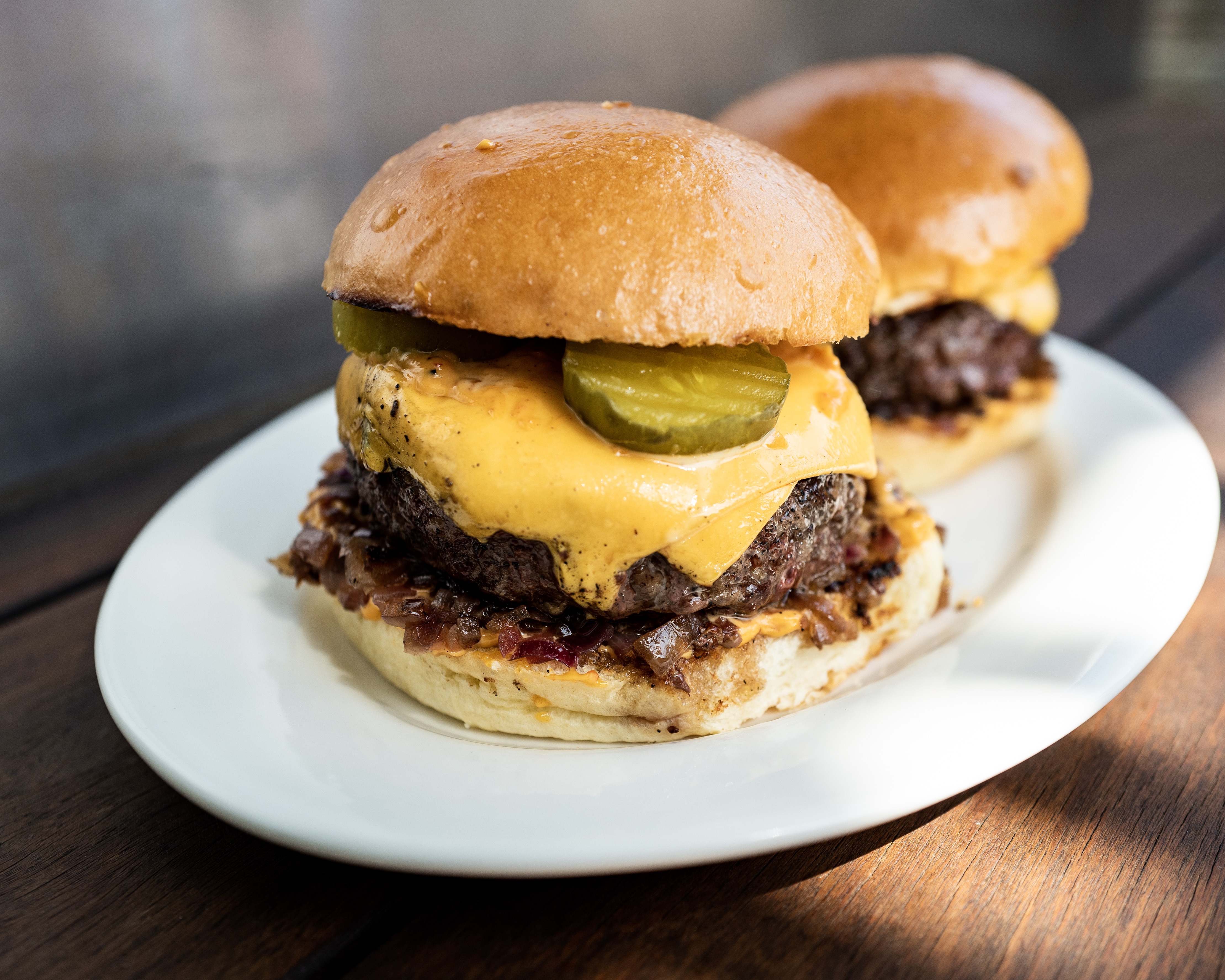
Pat LaFrieda says he got exposed to the idea of chopping beef at birth.
Pat LaFrieda Meat Purveyors.
A favorite of foodies and restaurateurs alike, Pat LaFrieda, the third-generation owner of Pat LaFrieda Meat Purveyors, has been ascending the NYC meat industry’s food chain since officially joining the family business in 1994.
The meat supplier for classic NYC restaurants like Eleven Madison Park and Minetta Tavern as well as national institutions like Shake Shack, LaFrieda is the butcher of choice for some of the greatest chefs in the U.S. and the scribe behind 2014’s Meat: Everything You Need to Know. It goes without saying that the 49-year-old meat maestro is a fountain of helpful tips about chuck beef and how to make a better burger.
His first suggestion for meat that can’t be beat? Chop your own beef with a grinder. This will allow you to combine different cuts (e.g., chuck, trimmed brisket, short rib, etc.) to create a blend that far exceeds the prepackaged ground meat typically available at the grocery store.

Pat LaFrieda
Evan Sung
“The difference between the two is vast,” LaFrieda tells InsideHook. “Ground beef is the net result of actually grinding and mixing meat into a homogenous paste. Chopped beef is the art of mincing and mixing meat in a very fine manner while visually and texturally keeping the proteins and fats separated.”
LaFrieda, who has determined after much experimentation that an 80:20 ratio of lean to fat is optimal, was sold on chopping his own meat by the two generations of butchers that came before him.
“Producing our own chopped beef is something my father and his father before him did,” he says. “It’s a hallmark of quality and is the only acceptable way to do it when you’re looking to put forth the finest product. It’s the core of what the company’s reputation for quality was built upon.”
Though chopping beef is a time-consuming process, doing it enables the finished product to better retain its texture and flavor. It also allows for customization, according to LaFrieda.
“We choose the ratio of cuts in each blend by determining the desired flavors first,” he says. “The levels of customization are endless but it is the desired flavor of a burger that dictates the blend used.”

A burger made with meat sourced from Pat LaFrieda Meat Purveyors
Pat LaFrieda Meat Purveyors.
LaFrieda, who notes that adding any spice to chopped beef other than salt or truffle produces a burger that’ll taste “like meatloaf,” suggests using a grinder that’s easy to clean and has an extraction neck measuring greater than 2 ½” in width that also comes with multiple sized dies, from 10mm to 3/16th.
“Look for brands that are well-known, produced in Germany or the U.S., offer support and parts if needed and have ample horsepower so that they do not seize during the grinding process,” he says. “Clean and sanitize your machine after each use and do not store any part in the freezer, as many suggest, before use.”
Below, adapted from Meat, is LaFrieda’s step-by-step guide to great chopped meat.
- Cut the meat into long strips that will fit into your meat grinder (1-inch wide does the trick for most home grinders). You never want to cut the meat into chunks. The long strips enable the meat to be pulled through the grinder by the auger, which is basically a big screw; it grabs the meat and drags it, so you don’t have to constantly push it through.
- Lay the meat in a single layer on a baking sheet and put it in the freezer to chill until it is stiff but still pliable and reaches the desired temperature, which varies depending on the type of meat. Chill the beef to 28° to 30°F before grinding it. Chilling the meat ensures that it won’t get pasty when it passes through the grinder. Use a meat thermometer to test the temperature before you pass the meat through the grinder.
- Fit the correct die onto your grinder; the size will vary depending on the recipe you are using. Some grinders come with only two dies, small and large. That’s fine; just pass the meat through the larger die first and then the smaller one.
- If your grinder has a speed setting, adjust it to the slowest setting. Slowing down the grinder speed prevents the meat from getting over-chopped.
- Put as much meat as comfortably fits in the hopper and pass it through the grinder into a large bowl, making sure to keep the meat moving steadily through and adding more meat to the hopper as there is room. If the meat passes through too slowly, the knife and plate will heat up and as a result “cook” the meat as it passes through. When the meat is moving through the grinder, its protein and fat act as a lubricant, keeping the blade and knife cool. Do not put those parts in the refrigerator or freezer before grinding meat. Chilling the parts will make them brittle and a piece could break off and end up in your food. Passed through at a steady pace, the meat will regulate the temperature perfectly.
- After you’ve passed the meat through the grinder the first time, take the head off the grinder. There will be a scrap of meat that didn’t get pushed through because there was no meat behind to push it. We call this “push meat.” Take the push meat out and set it aside so it’s there when you need it. (We put it on top of the grinder.)
- Change the die if the recipe you’re using calls for you to do so and put the head back on the grinder and tighten it up. Give the meat a gentle toss with your hands before adding it back to the grinder.
- Add the meat to the hopper. You will need to push it through using a long stick called a “bat,” “plunger,” “pusher” or “stomper.” Begin passing the meat through and adding more meat to the hopper as there is room. After you’ve added all the meat to the hopper, add the “push meat” to help push the meat through. The push meat never gets ground; it is sacrificed, but the idea is that you are only sacrificing one piece of meat instead of two.
- Your meat is now ready to use.
Subscribe here for our free daily newsletter.
July 27, 2020 at 09:57PM
https://ift.tt/3f8P6Cy
Master Butcher Pat LaFrieda Explains Why (and How) You Should Be Chopping Your Own Beef - InsideHook
https://ift.tt/2RxTDX4
Beef

No comments:
Post a Comment